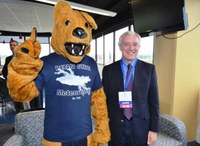Meteorologists needed in future to sort through ever-mounting data
By John Lindsey - Special to The Tribune, August 16, 2014, Weather Watch
Joel Myers — founder of AccuWeather — gave the lead presentation at the summer American Meteorological Society (AMS) meeting at Penn State University this past week. It was a sobering experience.
Myers said that all the data ever gathered (books, music, documents, movies, photographs and digital data) from the start of time until today will only represent one-hundredth of all the data ever collected just four years from now — and only one-millionth in eight years.
This type of exponential growth in data collection and processing will have profound effects on weather forecasting in the future. The numerical weather models, which weather forecasters depend upon for guidance, will become more powerful and accurate at an ever-increasing rate.
This left many of us wondering whether meteorologists will be needed in the not-too-distant future. Many experts agreed that robots and artificial intelligence will displace many workers in the future. We may all see a lot of 50-year-olds heading back to college.
However, the overall consensus at the AMS meeting points to a continued demand for weather forecasters. First of all, there will always be a need for humans to scan through the immense amounts of atmospheric and oceanographic data with a solid understanding of the science behind it and then be able to communicate the findings in a clear and understandable fashion to the public.
A real person also adds heuristic value. In other words, the ability to recognize similar weather patterns from the past that match current ones.
Another field in which meteorologists may be needed is energy. Study after study has shown that the greater amount of electricity that a country consumes, the longer the life expectancy of its citizens. Ever-increasing numbers of computers, servers, robots and other industrial and agricultural electrical applications combined with growing population, especially in the developing world, will increase the worldwide demand for electricity.
We will need to generate this electricity in a clean and efficient manner in order to reduce the amount of carbon flowing into the atmosphere and ocean. California is leading the way in clean and renewable energy sources.
Currently, more than 50 percent of the electricity that PG&E delivers to its customers is from carbon-free sources, such as nuclear from Diablo Canyon Power Plant and hydroelectric from various power plants throughout the Sierra Nevada. Of this, around 22 percent of this carbon-free energy is classified as renewable. In about six years, renewable energy sources will increase to 33 percent.
Unlike energy from nuclear and hydroelectric power plants, which produce energy at a predictable and constant rate, most renewable energy sources such as wind and solar are directly linked to current weather conditions that can vary from minute to minute.
For example, when clouds move overhead during the day, you can lose a significant amount of solar generation in a moment. On the other hand, when the clouds move away, you can quickly recover that solar generation. This sudden loss and gain of electrical generation will become a greater and greater challenge for grid operators.
Not only does the weather influence the amount of electricity generated, but it also affects the amount of energy consumed. When it warms up, folks turn on their air conditioners. To mitigate this situation, meteorologist and other scientists will need to develop weather models with the resolution and accuracy to predict the creation or clearing of clouds, the speed of the winds and accurate temperature predictions over countless very small geographic locations.
They also need to develop new ways in communicating this information to the grid operators so they can plan for variances in generation and demand throughout the day.
At this AMS meeting, I was amazed by the willingness of government, academics and private institutions to collaborate with each other to better serve the public. Everyone shared a common passion to preserve and protect life and property and promote public safety.
The students who attended this conference were brilliant. One of their instructors is Admiral David Titley, former oceanographer and navigator of the Navy. He is now a professor at Penn State and founding director of Penn State’s Center for Solutions to Weather and Climate Risk. The center will help organizations and citizens prosper and succeed in today and tomorrow’s weather and climate.
I couldn’t think of a better person to lead this organization and help us navigate into the future.
John Lindsey’s column is special to The Tribune. He is a media relations representative for PG&E and a longtime local meteorologist. He is president of the Point San Luis Lighthouse Keepers. If you have a question, send him an email at [email protected].
Read more here:
http://www.sanluisobispo.com/2014/08/16/3199353/meteorologists-needed-in-future.html?sp=/99/177/183/#storylink=cpy

